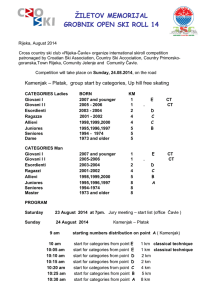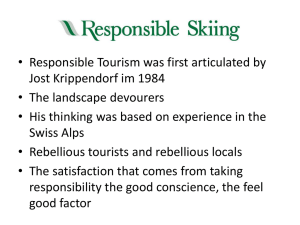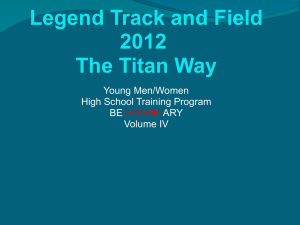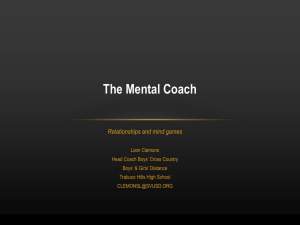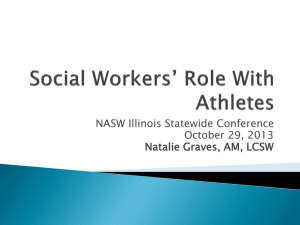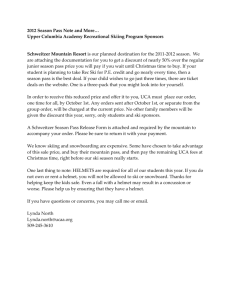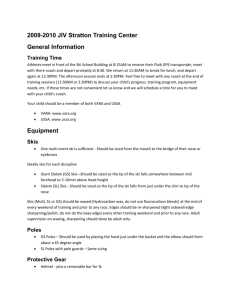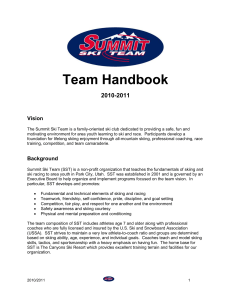U10 Handbook Winter 2015-16 Coaching Staff Marissa Haase (603
advertisement
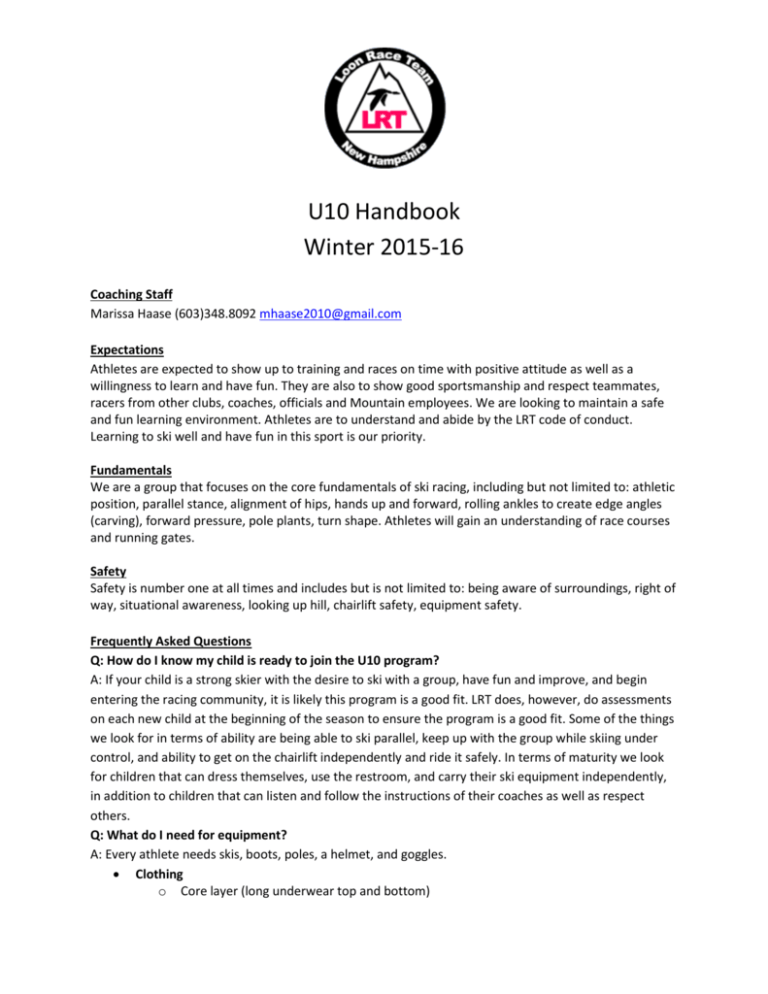
U10 Handbook Winter 2015-16 Coaching Staff Marissa Haase (603)348.8092 mhaase2010@gmail.com Expectations Athletes are expected to show up to training and races on time with positive attitude as well as a willingness to learn and have fun. They are also to show good sportsmanship and respect teammates, racers from other clubs, coaches, officials and Mountain employees. We are looking to maintain a safe and fun learning environment. Athletes are to understand and abide by the LRT code of conduct. Learning to ski well and have fun in this sport is our priority. Fundamentals We are a group that focuses on the core fundamentals of ski racing, including but not limited to: athletic position, parallel stance, alignment of hips, hands up and forward, rolling ankles to create edge angles (carving), forward pressure, pole plants, turn shape. Athletes will gain an understanding of race courses and running gates. Safety Safety is number one at all times and includes but is not limited to: being aware of surroundings, right of way, situational awareness, looking up hill, chairlift safety, equipment safety. Frequently Asked Questions Q: How do I know my child is ready to join the U10 program? A: If your child is a strong skier with the desire to ski with a group, have fun and improve, and begin entering the racing community, it is likely this program is a good fit. LRT does, however, do assessments on each new child at the beginning of the season to ensure the program is a good fit. Some of the things we look for in terms of ability are being able to ski parallel, keep up with the group while skiing under control, and ability to get on the chairlift independently and ride it safely. In terms of maturity we look for children that can dress themselves, use the restroom, and carry their ski equipment independently, in addition to children that can listen and follow the instructions of their coaches as well as respect others. Q: What do I need for equipment? A: Every athlete needs skis, boots, poles, a helmet, and goggles. Clothing o Core layer (long underwear top and bottom) o o o o o o o Mid layers (sweaters, sweatshirts, vests, weather depending) Ski socks Snow pants LRT Jacket Warm gloves/mittens (hand warmers and foot warmers recommended) Neck-up - Very important to cover the face to prevent frost bite/wind burn - DRESS FOR THE WEATHER!! It is recommended to pack extra clothing in a backpack to leave in the Comp Center Helmet o Choose a helmet that fits properly (NO soft ear flaps is preferred at this age, mandatory for older age groups). Helmet and goggles should both fit together allowing no space between the helmet and the goggles. When purchasing a helmet or goggles be sure to bring its counterpart to ensure the correct fit! o Getting a new helmet is strongly recommended. Helmets are not something that should be used for more than three years or 3 impacts. ie: falling off a table, falling out of the car, being dropped or kicked, the athlete falling and striking their head, getting hit, or even being thrown around when in a backpack. Ski Boots o Please pick a pair of boots that are not stiff. Three or four buckle, 50-70 flex. Athletes need to be able to flex the boot in order to achieve good body position and ski control. Boots are meant to be snug but still have some degree of comfort. o Boots are the foundation of skiing, if the athlete can not flex the boot or poor fitting boot they will struggle to improve their skiing. Hand- me- downs are acceptable if the boot fits but fit should be checked before beginning the season. Skis o o o Poles o Guards The best types of skis to buy are an entry level racing junior ski, length varies based on height. The ski should come up to about eye level depending on weight and ability. A dual ski is great for first year U10s. Athletes do not need Slalom and GS skis at this level. Second years or higher level athletes may want to purchase both even their skill and funding allows. Tuning - It is important to tune and maintain skis throughout the season to improve training. You can tune skis on your own or take them to a ski shop to be tuned, Ski tuning clinics are also offered throughout the season for those who would like to learn how to tune. It is recommended that skis are tuned for every weekend at this level. Learning to tune skis on your own is recommended. Continuous tuning can get expensive. Poles are the right length is when turned upside down and the child holds the pole just below the basket, the child’s elbow is at a right angle. See below for our Pole policy. o We will be skiing gates this year but athletes do not need full guards yet. We recommend chin guards and mouth guards to start. Prematurely getting shin guards and pole guards only cause the athlete to rotate trying to cross block the gates creating bad habits. As coaches, we will let you know when we feel your child is ready for these guards. Chin guards should only be worn in slalom but mouth guards can we worn constantly, even when free skiing. *Please make sure to put the athlete’s name in their clothing and on all equipment!* *Lots of equipment can be swapped and reused from other athletes (NOT helmets or boots)* *Check all equipment to make sure it is in good working condition!* Q: What happens if my child gets cold? A: Please remember to have your child dressed appropriately for the day’s weather, and dressed in layers! We will occasionally take a break to warm up, especially on frigid daysAthletes should be prepared with extra layers, neck warmer and mittens packed everyday. Q: Will my child get a break? A: Yes we will break most days but not every day. Please pack a few dollars in your child’s pocket for a snack and drink. Many parents choose to purchase food and beverage cards from Loon and attach to their children’s jackets, which is very convenient. Athletes may get small snacks and a drink. Candy should not be purchased at snack time. Q: When will we need ski poles? A: We won’t ski with poles for the first several days so that the child can focus on learning some very important fundamentals. Body position (athletic stance, hands up) is much easier to learn without poles. Further, poles are a distraction getting on and off the chairlifts and become a safety concern early in the season when the kids are still nervous about getting on the chair and holding the poles for the entire ride. Once we do start skiing with poles, in order to ensure safety and keep consistency, we enforce some rules with regards to poles. Poles may be taken away at any time for any of the following reasons: dropping them off the lift, poking people or swinging them around, skiing with hands down, or not listening and following coaches’ directions. Q: Where/when do I drop off and pick up my child? A: The Competition Center is located directly between the Governor’s lodge and the rental center on the West side. The U10’s depart from in front of the Competition Center at 8:00 each Saturday and Sunday morning. Please arrive at least 10 minutes early with each athlete ready to go (dressed, booted up, skis on) so we may have a prompt departure. We arrive back to the Comp Center at 11:30 for lunch, and head back out at 12:30. Pick-up is no later than 2:30. Q: What if I’m late? A: Please try to be on time, but we understand things happen. All coaches ski with a radio, ask another coach to radio the u10s. We may ask you to meet at the top or bottom of a lift. Coaches typically ski with their cell phones so feel free to call or text them as well. If you plan on showing up late/leaving early/half days/ etc., please notify a coach so we can plan accordingly. Q: Does LRT feed my child at lunch? A: No. Lunch is the responsibility of the child and parent(s); Athletes are on their own during this time usually eating lunch with friends and family in the comp center. Many families choose to eat together in the comp center, while some go to the Governor’s lodge or pavilion. Q: What happens if there is inclement weather? A: We normally ski, except in case of rain or extreme wind/cold. If this happens your coach will send an e-mail or post on the u10 page by 7am to let everyone know the plan for the day. Due to cold weather, rain, or depending on lift operations we may delay start or cancel after lunch. In rain, generally we cancel for the day. Q: What about vacations/holidays, who will be skiing with my child? A: We offer training for Christmas vacation and both Massachusetts and New Hampshire February vacations, as well as MLK day. Specific schedules for vacation weeks are sent out at least a week in advance, and usually contain at least one “day off” good for family days and rest. Schedules will be based on coach availability and athlete attendance. Occasionally your child may ski in an age group above to ensure adequate coach to athlete ratio. Q: Can I come ski with the group? A: Generally speaking, no. More often than not having a parent or other family around is distracting to the child and unproductive for the group. You are more than welcome to watch from afar and cheer on your child from the chairlift! We do occasionally allow shadowing for new families or parents wondering what our group is all about. Q: I see the group in the park, moguls and trees sometimes. I thought this was a race team? A: The goal for this group is to teach racing technique, however becoming a rounded skier is one of the most important things at this age. Teaching different varieties of skiing is what we do, and it’s how your child will ultimately become a better skier and ski racer. Skills learned in the park, bumps, and trees can be brought back into the race course. Q: What races should we sign up for? A: The U10’s have skills days that they won’t need to sign up for but will attend. January 16- Waterville February 2- Cannon March 12- Loon Athletes can sign up for open races if they would like. Some suggested by coaches are January 3- Zwahlen Memorial at Loon (SL) February 24- Tina Sutton Memorial (GS) Q: Does my child need any special licenses? A: Athletes with need both USSA and NHARA Licenses. Q: What and when are socials or banquets? A: These are very important for new families to attend. We encourage you to go, meet and chat with your coaches, and get to know the LRT families who can be a huge asset to you as you embark on this new lifestyle. There is always an opening social where coaches will be introduced and dinner served, and an end of year banquet with awards and trophies to hand out to athletes. In between, we hold a few socials for the athletes, parents, and coaches to get to know each other out side of ski gear. Q: What if my athlete is hurt, has allergies, special medications, etc.? A: In case of skiing accidents, coaches will stay with injured athletes until a parent or guardian arrives. Coaches will act as guardian, accompany athletes to first aid, hospital, fill out accident reports, etc. until the parent or guardian arrives. Please notify coaches if athletes have any special allergies/medications/conditions as well as provide proper instructions as well as the means to care for the athlete in case of an incident. Q: I’m concerned about chairlift safety. A: So are we! Safety is our number one priority. With that said, there are occasionally accidents when children are learning to load chairs especially at East Basin. It is our expectation that your child can load safely on all Loon chairs, but sometimes falls are inevitable if the child is not paying 100% attention when the chair comes around. We do extensive work teaching to get on at East Basin, and with the help of lift attendants are very successful. Please understand there will not always be a coach or adult riding the chair with your child: there just aren’t enough of us! We expect your child to understand how to sit on a chair and ride safely to the top. On high speed lifts where height requirements require an adult to be on the chair, we will utilize singles from the singles line when possible or older athletes if we can find them to ensure the children are safe on the chair. Q: What happens when my child misbehaves? A: Trust us we want this to happen as little as possible. We will give your child a few chances to adjust their behavior. If they are unable to get them self under control and are being disruptive, disrespectful, or unsafe it becomes a concert to us as coaches and will ask the athlete to sit in the competition center with an adult for a short period of time or until they are able to regain themselves. We will communicate and fully explain to you, as parents as well as the athlete, when this happens. We have a large group of athletes and would hate for anything to happen to any of them; whether it be feelings hurt, feeling excluded, being physically hurt, getting lost, or not being able to take full advantage of coaching due to another athlete’s behavior. Q: My athlete is having a hard time, and/or I have further questions, comments or concerns. A: Communication is open between athletes, parents and coaches. Please notify the head coach if there are any questions, comments or concerns. We will do our best to address these and improve the situation. Anything brought to us will be kept confidential. Please confide in your coaches!
